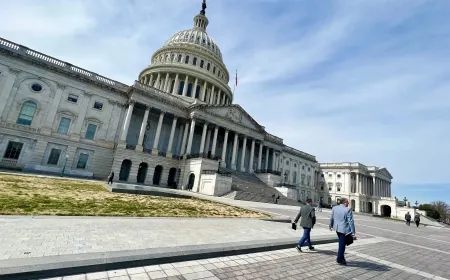Tariffs Threaten to Wipe Out 2026 Social Security COLA Gains
The 2026 COLA is projected at 2.7%, but tariffs could push prices higher, leaving seniors worried their benefits won’t cover rising costs.

The Social Security cost-of-living adjustment (COLA) for 2026 is expected to rise by 2.7%, based on preliminary projections from the Senior Citizens League. If confirmed, the increase would raise the average monthly retirement benefit of roughly $2,000 by about $54 starting in January 2026.
While the figure is slightly higher than the 2.5% adjustment in 2025, many retirees and policy analysts warn it may fall short of covering real household expenses. Costs for housing, medical care, and utilities have risen faster than overall inflation, and looming tariffs on imported goods could further strain budgets.
More than 70 million Americans, including retirees, disabled workers, and survivors, depend on Social Security benefits. Surveys show that more than half of older households already feel their checks do not cover basic needs, raising concerns that another modest COLA will deepen financial pressures heading into next year.
A History of Uneven Adjustments
Congress first authorized automatic cost-of-living adjustments in 1975, tying Social Security increases to the Consumer Price Index for Urban Wage Earners and Clerical Workers (CPI-W). Prior to that, benefit hikes required separate legislation, often leaving retirees waiting years for relief during high inflation.
Since then, COLAs have varied sharply depending on economic conditions. The largest increase came in 1980, when surging inflation above 13% pushed benefits up 14.3%. In contrast, the post-pandemic price spike resulted in an 8.7% COLA in 2023, the steepest in more than 40 years.
In years of low inflation, however, adjustments have been minimal or nonexistent. 2010, 2011, and 2016 brought no COLA at all, as measured inflation hovered near zero. The most recent increase in 2025 was 2.5%, lifting the average monthly check by about $50.
This uneven record underscores a recurring challenge: Social Security COLA calculations often lag behind the real costs seniors face, particularly in categories like healthcare, prescription drugs, and housing, which tend to rise faster than the broader CPI. As a result, even modest percentage changes can add up to hundreds of dollars in lost or gained income each year for beneficiaries.
Why Tariffs Are on Seniors’ Radar
Tariffs may sound like a debate for trade negotiators and Wall Street analysts, but their effects are felt directly at the checkout counter. When the government raises duties on imported goods, the costs rarely stay with foreign exporters—retailers and wholesalers often pass them on to American consumers.
The Trump administration’s 2025 tariff package, announced earlier this year, included sweeping increases: some rates reached 50% on goods from India and other major trading partners. The stated goal is to strengthen U.S. manufacturing and reduce reliance on foreign supply chains. But in practice, higher prices are already filtering into groceries, clothing, household products, and even medical supplies.
For retirees, that reality is especially painful. Seniors on fixed incomes have no way to bargain for higher wages or add extra work hours. Every uptick in essential expenses cuts into already limited monthly budgets, eroding the modest boost expected from Social Security’s 2026 cost-of-living adjustment (COLA).
“Retirees already tell us their checks don’t stretch as far as they once did,” said Tina Ambrozy, senior vice president at Nationwide. “Tariffs risk amplifying that pressure by raising prices in the very categories where older households are least flexible—groceries, utilities, and healthcare.”
Inflation and the Lag Effect
Tariffs and other price pressures often show up at the cash register long before they are captured in official government formulas. For Social Security recipients, that disconnect is built into the system.
The Social Security Administration calculates the annual cost-of-living adjustment (COLA) using the Consumer Price Index for Urban Wage Earners and Clerical Workers (CPI-W). The critical measuring period is July, August, and September each year. Whatever average inflation is recorded during those three months determines the COLA for the following January.
That timing creates what economists often call a lag effect. If prices spike in October or November, retirees feel the pinch immediately—higher grocery bills, higher heating costs—but the official COLA won’t reflect those increases until more than a year later.
History shows how painful this can be. During the energy price surge in late 2021, seniors endured months of higher utility and fuel costs that were not fully addressed until the 2023 COLA delivered an 8.7% increase—the largest in four decades. More recently, when inflation cooled after mid-2024, the 2025 COLA came in at just 2.5%, leaving many households struggling because their expenses had not fallen in line with the official index.
The result is a constant game of catch-up: benefits eventually rise to meet inflation, but rarely in real time. For retirees who have little cushion, that lag can mean putting off doctor visits, skipping prescription refills, or cutting back on groceries while waiting for Washington’s formulas to catch up with reality.
What Retirees Are Saying
The anxiety among older Americans is not theoretical—it shows up in survey data and daily choices. A recent Nationwide Retirement Institute poll illustrates the scale of concern:
-
Half of retirees (50%) said new tariffs will weaken their sense of income security.
-
Six in ten (61%) believe prices will rise faster than their benefits.
-
Nearly one in three (30%) admit they are dipping into savings more often just to cover essentials.
-
Roughly 20% said navigating their benefits has become more difficult this year compared with last.
Behind the numbers are stories that echo across the country. In Ohio, one retiree said she has cut her grocery list nearly in half because weekly shopping trips are swallowing a growing share of her fixed income. In Florida, another admitted she now waits for her Social Security check to clear before refilling some prescriptions, a delay that carries obvious health risks.
Advocacy groups warn these choices reflect a broader pattern. “When your rent, utilities, and Medicare premiums all rise together, there’s no margin left for flexibility,” said Shannon Benton, executive director of the Senior Citizens League. “A $50 adjustment doesn’t come close to covering those increases.”
Economists caution that even modest inflation, when paired with rising health costs and housing pressures, can compound quickly for seniors. Unlike younger workers, retirees cannot simply extend work hours or negotiate higher pay—they live within the strict limits of their monthly benefits.
Other Pressures on Retiree Budgets
While tariffs have dominated headlines this year, they are far from the only challenge squeezing older Americans’ budgets. A closer look at the numbers shows the depth of the strain:
-
Housing costs remain a persistent burden. According to the latest Consumer Price Index, shelter inflation is running above the overall average, with rents and property taxes climbing steadily. For retirees on fixed incomes, rising property taxes can mean hundreds of dollars more per year—costs that Social Security increases rarely offset.
-
Healthcare expenses are accelerating. Government data shows medical services, especially hospital stays, outpatient visits, and prescription drugs, have outpaced general inflation for much of the past decade. Even with Medicare coverage, seniors often face copays, deductibles, and uncovered expenses that erode their monthly checks.
-
Food prices are under pressure from multiple fronts. Beyond tariffs, costs are being driven higher by global supply chain issues, extreme weather affecting harvests, and persistent labor shortages in agriculture and food processing. Staples like bread, eggs, and fresh produce have all seen double-digit increases at points in the last three years.
These costs strike hardest because they are non-discretionary. A retiree can postpone buying a new appliance, but not a prescription refill or an electricity payment. Unlike younger households, seniors have little flexibility to shift spending, pick up extra hours at work, or ride out periods of higher inflation by adjusting earnings.
“Older households are uniquely vulnerable because the categories inflating fastest are the ones they spend the most on—housing, healthcare, and food,” said Richard Johnson, an economist at the Urban Institute. “That’s what makes modest COLA increases feel insufficient, even when they are technically keeping pace with the CPI.”
Questions About the Data
Some economists argue that the current inflation yardstick—the Consumer Price Index for Urban Wage Earners and Clerical Workers (CPI-W)—does not reflect seniors’ real expenses. CPI-W was designed to track costs for working households, not retirees, and it underweights categories like healthcare and housing that make up a larger share of older Americans’ budgets.
An alternative measure, the Consumer Price Index for the Elderly (CPI-E), has generally shown faster price growth than CPI-W, suggesting that retirees face steeper inflation. While CPI-E remains experimental and is not used for Social Security adjustments, advocates argue it would better capture the spending realities of households 62 and older.
Concerns about accuracy extend beyond methodology. The Bureau of Labor Statistics (BLS), which compiles price data, has faced staffing and budget pressures in recent years. Some experts warn that fewer surveys and political pressure to keep inflation estimates low could result in cost-of-living adjustments (COLAs) that fail to keep pace with what seniors actually pay.
Politics and Policy
Tariffs are more than an economic lever — they are a political weapon. The Trump administration has relied heavily on tariffs as part of its trade agenda, framing them as protection for American industries and workers. Supporters argue that the measures help reduce foreign competition and bring jobs back to the U.S.
Critics counter that tariffs function as a hidden tax on consumers, driving up costs for households. Economists note that while manufacturers may benefit from reduced competition, families pay more for imported goods, from groceries to medical equipment.
The political arguments play out in Washington, but the financial consequences land in everyday budgets. Retirees, who spend a larger share of their income on food, medicine, and housing, experience the effects directly. Higher checkout totals at supermarkets, steeper pharmacy bills, and rising utility charges are where the trade policy debate becomes personal for older Americans.
Retirement Realities Tied to Social Security
Social Security remains the central income source for millions of retirees. According to the Social Security Administration, about 40% of beneficiaries receive at least half of their income from the program, and 14% rely on it for 90% or more.
That dependence makes the annual cost-of-living adjustment (COLA) a critical factor in household budgets. For retirees with pensions, savings, or investments, a modest adjustment may matter less. For those living almost entirely on Social Security, it can determine whether essential costs—like rent, food, or healthcare—are covered.
At the same time, the trust fund that finances benefits is projected to run short in the mid-2030s unless Congress acts. Options under debate include raising payroll taxes, reducing benefits, or increasing the retirement age. With no agreement in sight, each COLA announcement comes against a backdrop of uncertainty about the program’s long-term stability.
What to Expect This Fall
The Social Security Administration will announce the official 2026 cost-of-living adjustment (COLA) in mid-October, after September inflation data is published. The current projection of 2.7% remains an estimate. A sharp rise in consumer prices could lift the final figure, while stable inflation would likely keep it close to that level.
Whatever the outcome, the new adjustment will take effect in January 2026 and apply to more than 70 million Social Security recipients.
How Seniors Can Prepare
Financial experts say retirees can take several steps to manage the gap between rising costs and Social Security adjustments:
-
Track expenses carefully to see which categories—such as food, utilities, or healthcare—are straining budgets the most.
-
Review Medicare coverage during open enrollment, since premium changes can cancel out COLA gains.
-
Explore part-time work or flexible income sources if health allows, as even modest earnings can provide relief.
-
Keep emergency savings available, because inflation shocks often arrive months before benefit increases.
Advisors also caution against drawing down retirement accounts too quickly, warning that inflation and market volatility can make portfolios harder to rebuild.
When a Raise Doesn’t Feel Like One
The 2026 COLA is meant to track inflation, but it won’t erase seniors’ biggest concerns. For retirees living on fixed budgets, new tariffs add costs just as higher grocery, housing, and healthcare bills strain household income.
The real question is whether the January increase will make a difference at the checkout line—or if rising prices will wipe out the gain before it arrives.






























































